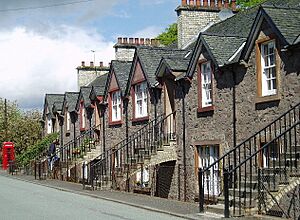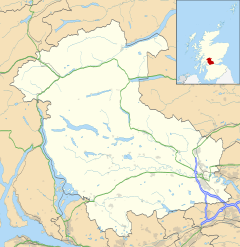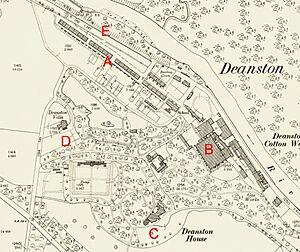Deanston facts for kids
Quick facts for kids Deanston
|
|
|---|---|
 Mill workers' houses, Deanston |
|
| OS grid reference | NN713016 |
| Civil parish |
|
| Council area | |
| Lieutenancy area |
|
| Country | Scotland |
| Sovereign state | United Kingdom |
| Post town | DOUNE |
| Postcode district | FK16 |
| Dialling code | 01786 |
| Police | Central Scotland |
| Fire | Central Scotland |
| Ambulance | Scottish |
| EU Parliament | Scotland |
| UK Parliament |
|
| Scottish Parliament |
|
Deanston (which is Baile an Deadhain in Scottish Gaelic) is a small village in Scotland. It's located in the Stirling area, right by the River Teith. This village is part of a larger area known as Kilmadock.
Contents
What's in a Name?
The name Deanston comes from a person named Walter Drummond. He was a 'Dean' (a church official) in the year 1500. The area was first called Deans Town. Walter Drummond bought the land that is now Deanston. He bought it from the Haldanes family from Gleneagles.
The Famous Deanston Mill

The Deanston Cotton Mill was built in 1785. It was started by the Buchanan brothers from near Glasgow. They used the power of the River Teith to run the mill. In 1808, a company called James Finlay & Co bought the mill. They made it much bigger. They even built a long water channel, called a Lade, that was about 1,500 meters long.
James Smith was the manager of the mill from 1807. He was a very clever inventor and businessman. He built special homes for the workers. These homes were called 'divisions' and had four levels. This was a very new idea at the time. When the mill was busiest, over 1,000 people worked there. It also had the biggest waterwheel in Europe. This giant wheel was called Hercules and was about 36 feet (11 meters) across!
The cotton mill closed down in 1965. But the site didn't stay empty for long! In 1966, the Deanston Distillery opened there. This distillery makes whisky. It also produces a lot of electricity for the country's power grid.
Exploring Deanston Village
Deanston is a special place. The whole village, including the old mill buildings and Deanston House, is a 'Conservation Area'. This means its history and buildings are protected. Many of the buildings are 'Listed', which means they are important and kept safe.
The homes in Deanston village (marked 'A' on the map) are mostly in one long street. There are five blocks of terraced houses. These were known as 'Divisions'. This unusual design was probably because the village is on a narrow flat area next to the River Teith. The land rises steeply behind it.
- The houses on the north side (numbers 1 to 17) were built around 1811. These were for the mill overseers.
- On the south side, four blocks were built for the mill workers and their families. Blocks 12 to 22 were built around 1811. The rest were built around 1820. All these buildings are from the Georgian era.
- The houses had three floors. The workers' homes had a shared entrance.
The Mill buildings (marked 'B' on the map) started being built in 1785. They changed a lot over the years. There was even a big fire in 1796. The large five-story Spinning Mill was built between 1830 and 1831. The Weaving Shed was built around 1830. Both of these are very important historical buildings. The mill closed in 1965. But it reopened the next year as a whisky distillery. So, all the buildings were given a new purpose. You can still see parts of the original mill, like the pits where the water wheels used to be.
Deanston House (marked 'C' on the map) was built around 1820. It was made much bigger between 1881 and 1883. The house had large grounds, which also changed over time. Deanston Villa (marked 'D'), which was built for the Mill Manager, is still standing. Much of the walls of the original walled garden are also still there. Some of the land to the west of the house has been used for new homes built in the 20th century.
Perhaps the most amazing part of the village is the mill lade (marked 'E' on the map). This water channel is about 1.5 kilometers long! It was built around 1826. It replaced an older, shorter lade. Its job was to bring water from the River Teith to power five huge waterwheels. The lade runs above ground for most of its length. But it goes underground about 200 meters before it reaches the mill. Old maps from 1862 show this design.
Deanston is important because it's one of only a few planned villages in Scotland. These villages were built in the 1700s for cotton spinning. Other similar villages include New Lanark, Stanley, and Catrine. These villages were built after Richard Arkwright, a very important person in the Industrial Revolution, came to Scotland. He wanted to set up cotton spinning factories based on his ideas. None of these four villages are exactly as they were. But together, they show us a great picture of how these early industrial villages were designed and worked.
Famous People from Deanston
Deanston has connections to some important people:
- Two Lord Provosts of Glasgow (like a mayor) came from Deanston: Sir John Muir and Sir David Richmond.
- John Grierson, a pioneer in making documentary films, was born in Deanston. A street in the village is named after him. John Grierson built the first play-park in Deanston. His grandmother's ashes were scattered under the swings there.
- James Tod of Deanston was the laird (landowner) of Deanston from about 1830 to 1858.



